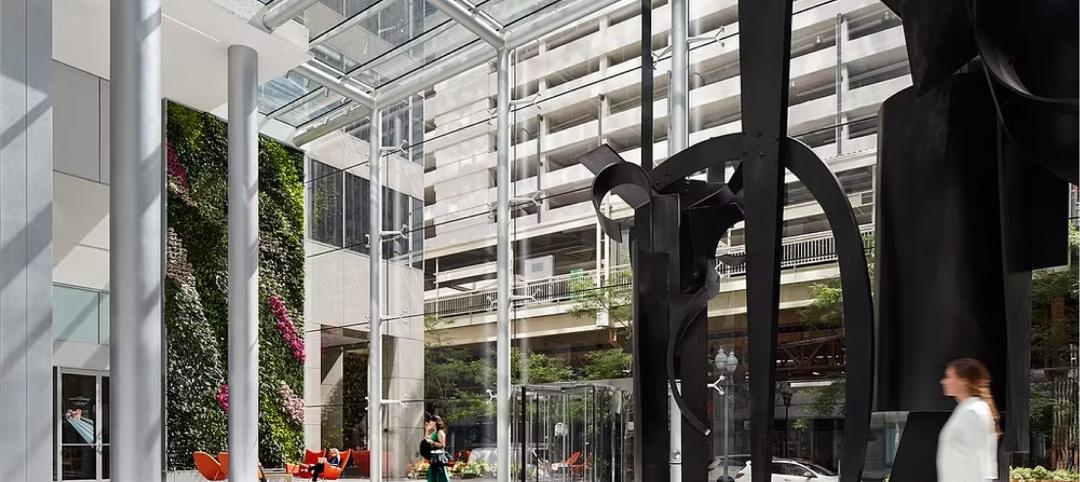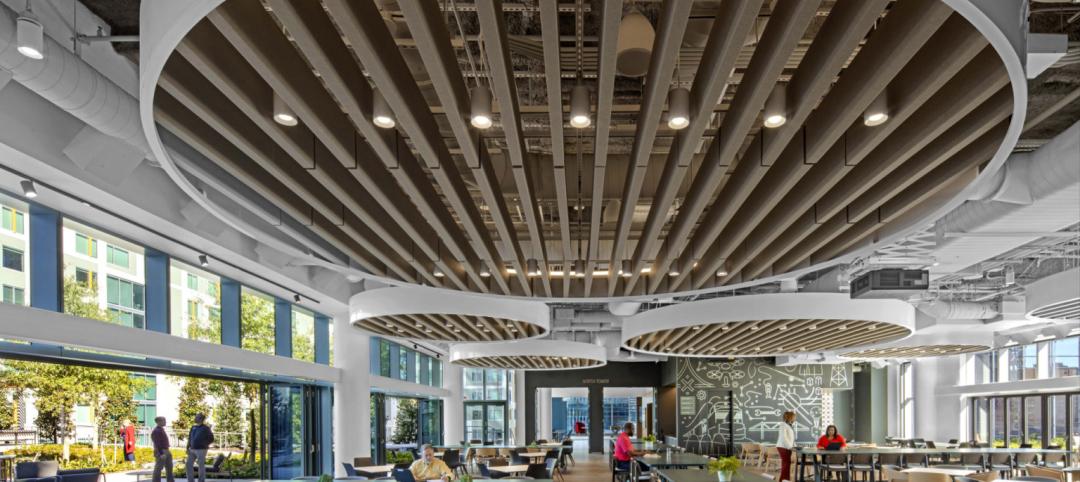Time Warner’s new 1.5-million-sf headquarters will bring together more than 5,000 employees representing five distinct media and entertainment brands: Time Warner, Warner Bros., Turner, CNN, and HBO. The joint workplace will be housed in the 30 Hudson Yards tower under construction on Manhattan’s West Side.
Time Warner believes the consolidated office will deliver bottom-line benefits—not just cost savings but also "a great space for our employees," says Joel Brenner, AIA, Vice President of Global Project Management.
Many companies recognize the value of creating a centralized work community. “We’ve seen several office consolidations and moves to take advantage of new technologies and having all employees under one roof,” says Dan Novack, Vice President, Business Acquisition, Balfour Beatty.
See also: Top 200 Office Architecture + AE Firms - 2018 Giants 300 rankings
See also: Top 90 Office Engineering + EA Firms - 2018 Giants 300 rankings
See also: Top 120 Office Construction + CM Firms - 2018 Giants 300 rankings
Fannie Mae, the federally owned mortgage loan company, is consolidating its Washington, D.C., headquarters from five locations to the new Midtown Center downtown. The new space, which has 80% fewer enclosed offices, could save taxpayers $300 million over the term of a 15-year lease.
Fannie Mae also plans to relocate workers from multiple locations across Northern Virginia to a single office at Reston Gateway, a two-tower, 1.1 million-sf office complex under development in Reston, Va. The project will have a 20-foot-high "super floor" that spans both buildings to provide a multi-functional amenities/community space, says Novack.
Because the current workforce is composed of four distinct generations—each with its unique needs, preferences, and values—office designers are building flexibility into the spaces they create.
“Millennials and Gen Y employees are digital natives who prefer a work environment where they can choose how, where, and with whom they work and collaborate,” says Stantec's Angie Lee, FAIA, IIDA, LEED AP, Senior Principal. “While individual space keeps getting smaller, a new menu of custom-designed spaces and activities is on the rise.”
To meet the varying preferences of a multi-generational workforce, designers recognize they must first understand the user experience (UX). “User profiling is becoming a top priority in workplace design,” says John Capobianco, Design Director and Principal, Interior Architects. The firm went through an extensive workplace strategy process, including visioning sessions and focus groups, for the design of a consulting firm’s new office—"both from a current employee perspective and a recruiting one,” says Capobianco.
Now that Millennials make up the largest group in the U.S. labor force, many of today’s office spaces reflect a blurring of the traditional distinctions between the work and non-work.
“Because work, live, and play are no longer considered
distinct activities, companies need to design their space to support every activity, including socializing, learning, and community building,” says Andy Cohen, FAIA, IIDA, Co-CEO of Gensler. “This affects everything from how we think about work and co-working to mobility and buying trends, all of which can make a tremendous impact on how we approach and deliver design.”
See Also: University trends 2018: Schools are desperately searching for ways to economize
In late 2017, Reebok relocated its headquarters from suburban Boston to the city's Seaport District. Housed in a former waterside storehouse for the South Boston Army Base, the 220,000-sf activity-based workplace is designed as a collection of neighborhoods. There are no assigned seats.
A two-story fitness center features a boxing ring alongside cycling, yoga, and dance studios. Visitors can order customized shoes—and watch them being assembled—at the first-floor flagship retail space. Beyond seeking to attract top-tier design talent, Reebok wanted to energize its maker culture and integrate its brand within Boston’s innovation community.
BUILDING THE TECHNOLOGY INFRASTRUCTURE
The growth of collaborative work environments is driving a proliferation of innovative ceiling, wall, and floor systems.
“A new headquarters space could have over 100 light fixture types, a dozen floor and ceiling systems, and a variety of color schemes and finished wall surfaces to create a more comfortable and healthy workspace for employees,” says James Donaghy, Executive Chairman at Structure Tone.
Today’s workplaces are also equipped with sophisticated conference centers and public assembly areas with increasingly complex audio-visual and IT systems that impact construction sequencing and project scheduling, says Donaghy.
“We must tighten up the construction schedule on submittals and material delivery to ensure we start and complete above-ceiling commissioning and inspections earlier to give the A/V and IT contractors sufficient time to complete their work,” he says. “Then these new systems must be tested and commissioned before the move.”
Office lobbies are becoming active social spaces that include lounge seating, art installations, and coffee bars. “Clients are turning their lobbies into destinations instead of pass-through spaces,” says Bert Rahm, Vice President and General Manager of Turner Construction Company. “They’re raising ceiling heights, removing columns, and emphasizing natural light to create a much more inviting atmosphere for tenants, visitors, and the general public.”
“Smart cities and co-working groups are challenging the traditional real estate model,” says David Bourke, Co-CEO and Co-President, Interior Architects. “The role of design has never been more important.”
Related Stories
Mixed-Use | Jun 1, 2023
The Moore Building, a 16-story office and retail development, opens in Nashville’s Music Row district
Named after Elvis Presley’s onetime guitarist, The Moore Building, a 16-story office building with ground-floor retail space, has opened in Nashville’s Music Row district. Developed by Portman and Creed Investment Company and designed by Gresham Smith, The Moore Building offers 236,000 sf of office space and 8,500 sf of ground-floor retail.
Office Buildings | May 24, 2023
The future of work: What to expect in 2023
While no one disagrees that the workplace has undergone tectonic changes, it is less clear how to understand these shifts and synthesize them into practical action for the coming year.
Multifamily Housing | May 23, 2023
One out of three office buildings in largest U.S. cities are suitable for residential conversion
Roughly one in three office buildings in the largest U.S. cities are well suited to be converted to multifamily residential properties, according to a study by global real estate firm Avison Young. Some 6,206 buildings across 10 U.S. cities present viable opportunities for conversion to residential use.
Headquarters | May 16, 2023
Workplace HQ for party clothing company Shinesty celebrates its bold, whimsical products
The new Denver headquarters for Shinesty, a party clothing company, was designed to match the brand’s fun image with an iconic array of colors, textures, and prints curated by the design agency, Maximalist. Shinesty’s mission, to challenge the world to live more freely and “take itself less seriously,” is embodied throughout the office interior.
Office Buildings | May 15, 2023
Sixteen-story office tower will use 40% less energy than an average NYC office building
This month marks the completion of a new 16-story office tower that is being promoted as New York City’s most sustainable office structure. That boast is backed by an innovative HVAC system that features geothermal wells, dedicated outdoor air system (DOAS) units, radiant heating and cooling, and a sophisticated control system to ensure that the elements work optimally together.
Headquarters | May 15, 2023
The new definition of Class A property
Dan Cheetham, Managing Director and Founder of FYOOG, believes organizations returning to a "hub and spoke" model could have a profound effect on properties once considered Class B.
Headquarters | May 9, 2023
New Wells Fargo development in Texas will be bank’s first net-positive campus
A new Wells Fargo development in the Dallas metroplex will be the national bank’s first net-positive campus, expected to generate more energy than it uses. The 850,000-sf project on 22 acres will generate power from solar panels and provide electric vehicle charging stations.
Digital Twin | May 8, 2023
What AEC professionals should know about digital twins
A growing number of AEC firms and building owners are finding value in implementing digital twins to unify design, construction, and operational data.
Office Buildings | May 5, 2023
9 workplace design trends for 2023
HOK Director of WorkPlace Kay Sargent and Director of Interiors Tom Polucci discuss the trends shaping office design in 2023.
Office Buildings | May 4, 2023
In Southern California, a former industrial zone continues to revitalize with an award-winning office property
In Culver City, Calif., Del Amo Construction, a construction company based in Southern California, has completed the adaptive reuse of 3516 Schaefer St, a new office property. 3516 Schaefer is located in Culver City’s redeveloped Hayden Tract neighborhood, a former industrial zone that has become a technology and corporate hub.

















